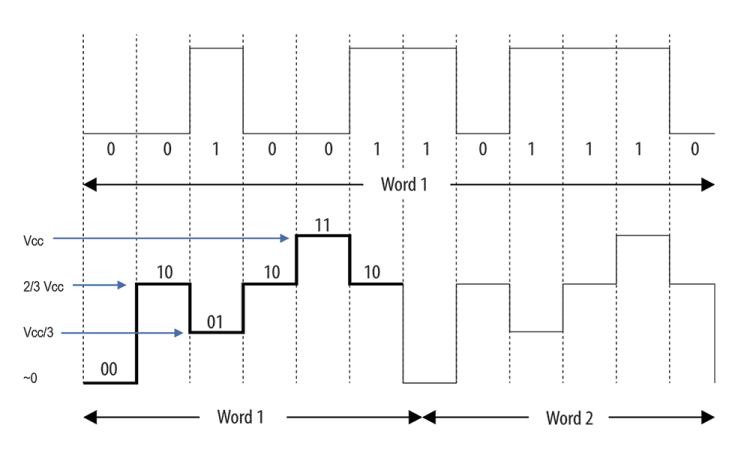
The latest version of the PCI Express standard, 6.0, doubled the data rate of the PCIe 5.0 specification, while still maintaining backwards compatibility. Key features of the PCIe 6.0 specification include:
• 64 GT/s data rate and up to 256 Gbps via x16 configuration.
• PAM4 signalling.
• FEC and CRC mitigate the bit error rate increase associated with PAM4 signalling.
• Maintains backwards compatibility with all previous generations of PCIe technology.
PAM stands for pulse amplitude modulation, with the number four representing the number of signalling levels.
A common modulation technique is known as NRZ, or non-return to zero. NRZ uses two levels of signalling. When the level is ~0 V, a logic 0 is sent. When the level is ~1,8/3,3/5 V, then a logic 1 is sent. Each unit interval sends a zero or a one meaning that NRZ is basically PAM2 modulation.
PAM4 is a multi-level protocol that uses four levels of signalling. These levels correspond to ~0 V, Vcc/3, (2 x Vcc)/3, and Vcc. Additionally, each unit interval transmits two bits instead of one – either a 00, 01, 10, or a 11.
Figure 1 shows an example of PAM4, compared to NRZ encoding when transmitting the word 00 10 01 10 11 10.

Previously, PCIe specifications used NRZ or PAM2. But, due to the limitations in data transfer, PAM4 specification has been adopted, starting with 56 Gbps, 112 Gbps, and in the near future, 224 Gbps. PAM4 enables the doubling of the data throughput, while using the same Nyquist frequency used by an NRZ modulation system.
For example, PCIe 5.0 architecture uses a Nyquist frequency of 16 GHz, providing a maximum transfer rate of 32 GT/s, a maximum unidirectional bandwidth of 64 Gbps, and a maximum bidirectional bandwidth of 128 Gbps. Using the same 16 GHz frequency, but switching to a PAM4 modulation scheme used by PCIe 6.0, doubles the data rate to 64 GT/s per link thereby providing a bidirectional bandwidth up to 256 Gbps.
PAM4 also reduces channel loss because it operates at half the frequency for the same amount of data as a PAM2 scheme. Hence, for the same frequency, the data rate is doubled.
PAM4 enables the PCIe 6.0 specification to be used for applications requiring large data throughput, such as artificial intelligence and machine learning, automotive, IIoT, and military/aerospace.
| Tel: | +27 10 447 0180 |
| Email: | [email protected] |
| www: | www.avnet.com/wps/portal/abacus |
| Articles: | More information and articles about Avnet Abacus |

© Technews Publishing (Pty) Ltd | All Rights Reserved